One, if you do not need to move a single method , do not move the injured. Glance at the escape route to determine the best way and route to take care of the wounded. If you are alone and you must quickly displace the wounded, try the following emergency evacuation methods.
(I) Support Law
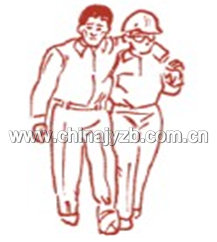
This method is only applicable to the wounded who can walk on their own. This is a simple way to transfer minor injuries to the wounded.
(b) Dragging
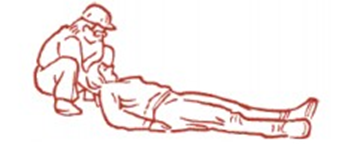
This method of handling is suitable for dragging a wounded person lying on the back or a wounded person sitting in a seated position. Gently put your hands under the armpits of the casualty, grab the clothes on both sides and support the head of the casualty between your forearms. Drag the wounded person back to the nearest safe place. Be careful not to suffocate when dragging and dropping their clothes.
(three) the method of dragging

For a wounded person who can move using the drag method, if there is a blanket, the rescuer can also move the wounded person to the blanket for dragging.
(iv) Carrying method
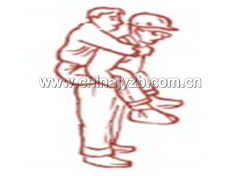
Put a standing or sitting wounded person on your back. Do not use this method if the casualty is unaware or injured.
(five) move downstairs
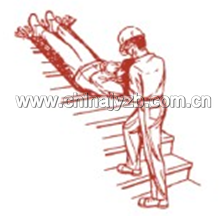
Do not use this method if you suspect the head or spine of the casualty is injured or amputated. If possible, place a mattress or carpet under the wounded person.
(six) crawling method

Use bandages or ripped shirts to tie the casualty's hands together and put tight gloves around your neck. In this way you can move people who are heavier than you.
Second, the double rescue method
(A) seat handling method
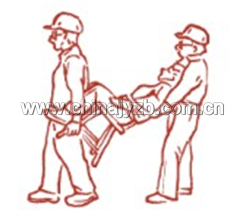
The seat handling method can be used to transport conscious or unconscious wounded personnel, but it cannot be used by wounded people who suffer from injuries to the head or spine. In order to protect the wounded, the wounded person's hand is fixed on his chest. If the wounded is unconscious, the wounded person should be fixed on the chair.
(two) hands lift method
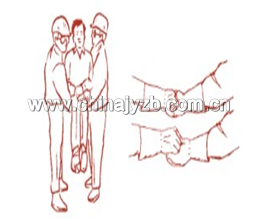
The two-handed lift method is another transport method that can be used when the wounded is conscious but cannot walk or support the upper body. The two rescuers bent the palms of their ten fingers into hooks and hooked each other's fingers. If you do not have gloves, please use a piece of cloth to wrap your hands to protect your hands from being scratched by the opponent's nails. This is another reason to wear gloves in the rescue.
(c) Four-handed lift method
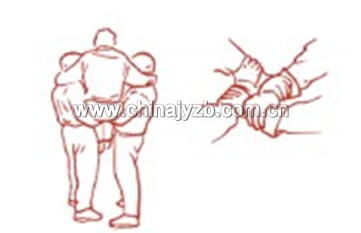
This method can also be used as a good way to carry a conscious, wounded person who can use both hands and arms to support the body.
Third, more people handling method
If there are more than two people involved in the rescue, there are many different ways to transport the injured.
(1) Blanket Handling
Do not use this method when the head or spine of the injured person may be injured.
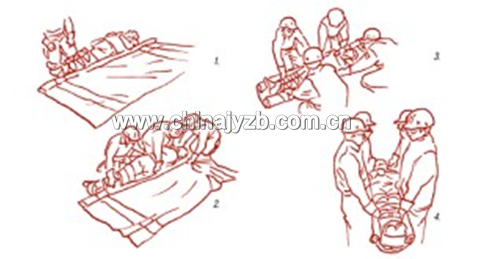
1. Wrap a carpet or rug longitudinally to half the width. The carrier is located on the head and feet of the wounded person, putting the head, neck and trunk of the injured person in a straight line.
2. Lay down on the shoulders of the injured person and place something on the back of the injured person to help the wounded side. The wounded side of the wounded person should be below. When turning over, turn the wounded as a whole so that the wounded body will not be distorted.
3. Roll the wounded person's back to the blanket with his face facing up. Unfold the blanket and re-roll the edges of the blanket to the sides of the wounded. The carrier grasped the side of the blanket in the head, shoulders, hips and legs of the injured person and was ready to lift the wounded.
4. Keep the blanket tight while the wounded person is lifted and put on the stretcher.
(b) The three-person transport method This method can be used to transport seriously injured people without increasing the damage. You can carry the wounded forward, move sideways or down on the stretcher.
(c) Easy Stretcher
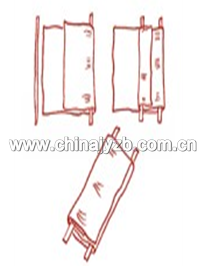
If you can't get a regular stretcher, you can use it locally, use a tabletop or a door panel as a stretcher, or use two rigid bars and a blanket or clothing to make a stretcher. Do not use a non-rigid stretcher to transport wounded personnel who are suspected of having a head or spine injury.
1. Make a stretcher with a blanket and a long rod (1) Place the blanket on the ground and place the long rod on the blanket. The long rod is one-third of the side of the blanket. Fold the cover one third inward. Stay long.
(2) Place the second pole not parallel to the first pole in the folded portion of the felt, approximately 15 cm (6 inches) from the edge of the folded portion of the felt.
(3) Fold the remaining blanket over the two long rods. The weight of the wounded on the blanket does not allow the blanket to slide off the pole.
2. Stretching stretcher doors, short ladders, and galvanized sheets on the spot can be used as temporary stretchers, so please be careful about suitable materials.
Make sure that the stretcher and the wounded can pass through all the channels and confirm that the stretcher is strong enough to carry the wounded.
Note: To use a person with similar or heavier weight, test whether the stretcher is strong enough to carry the wounded. To check whether the length and width of the stretcher can be guaranteed to pass through aisles, doors and stairs without damaging the wounded.
3. Blanket Stretcher
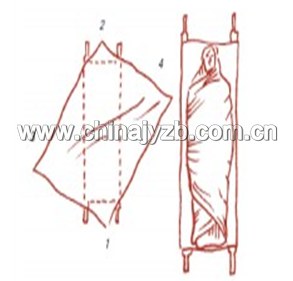
A blanket can wrap the wounded for warmth and also facilitate the treatment of the wound.
Lay the blanket diagonally on the stretcher. Put the folded down edge back on both sides of the stretcher bed to prevent mopping. After placing the wounded person on the stretcher, cover the foot with the bottom corner (1 in the figure) and then poke between the two feet. Cover the head and neck with the tip of the head (2). Cover the wounded with the other two sides.
4. Stretch the wounded with a stretcher

If you have to transport a wounded person on a bumpy ground or a rubble pile, you must use a double knot to fix the wounded person on a stretcher. A double knot was placed on the handle of the early stretcher. From there, a series of half knots were used to secure the wounded in the middle of the chest, buttocks, hips and knees.
5. The stretcher must be carried by at least four people to carry the stretcher. The general carrier is facing the direction of advancement and the wounded person's foot is at the front. When climbing upstairs, going upstairs, moving into an ambulance, or moving into bed? 蛴ν åè°‡ åè°‡ åè°‡ åè°‡ åè°‡ åè°‡ åè°‡ åè°‡ åè°‡ åè°‡ åè°‡ åè°‡ åè°‡ åè°‡ åè°‡ åè°‡ åè°‡ åè°‡ åè°‡ åè°‡ åè°‡ åè°‡ åè°‡ br è®°ä½ br br br 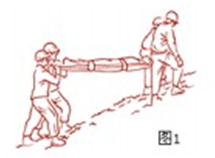
6. Uneven ground and obstacles When passing uneven ground, four people should stretch the stretcher and keep it as horizontal as possible.
Rescuers need to adjust the height of stretchers from time to time to compensate for the effects of topographic relief.
If the ground is not stable, the stretcher should be carried by a row of six to eight people instead of the carrier carrying the stretcher to walk on the gravel, especially when the stretcher is put down, because the children who tied the wounded at these times may tighten up. .
As you pass through the doorway, the foremost carrier should move to the middle of the stretcher and let the front end of the stretcher extend out of the door. The rescuers passed through the door one by one and then lifted the stretcher again.
Avoid moving across walls or high obstacles while moving, even if it means that you need to take a longer road. When you must cross the wall, follow these steps:
(1) Raise the stretcher and support the front handle of the stretcher on the wall. The back person keeps the stretcher level and the front man then crosses the wall.
(2) All carriers raise the stretcher together and move the stretcher forward until the rear handle is resting on the wall. Afterwards, the following people crossed the wall.
V. Rescue and transportation of the wounded in a seated position Occasionally in an earthquake or explosion, the wounded will sit in the car. When the situation is critical and you only have one person and you must remove the seated person from the vehicle immediately, follow these steps:
1. Free the injured person's foot from the wreckage and move it near the exit. Gently insert one of your forearms under the armpit near the exit of the victim and extend your hand to support the victim's lower jaw.
2. Gently bring the victim's head back to your shoulder and keep the victim's neck as straight as possible.
3. Gently insert your other forearm under the armpit on the other side of the victim and place the victim close to the wrist on the exit side.
4. Stand firm and turn the wounded. Try to keep your neck straight and pull the injured person from the car to a safe distance. The less you twist your injured body, the better.
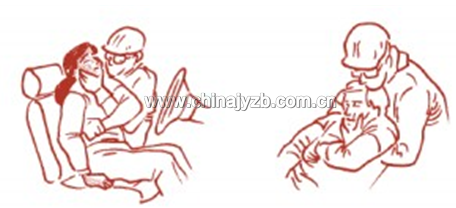
All the injured may feel discomfort and increase pain due to rescue actions. Remember, don't move the wounded more, so that you can safely wait for one step. Only those things necessary to ensure the safety of the wounded are necessary to do it. Afterwards, continue comforting the injured with intuition, if possible, keeping him with him until further assistance arrives.
Gate Valve,Fluorine Lined Gate Valve,Sluice Valve,Carbon Steel Gate Valve
Zhejiang Meide Machinery Co.,Ltd , https://www.meidemachinery.com